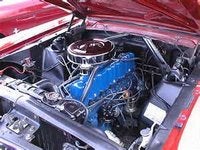High Altitude adjustments to carb
Asked by drjeckles Feb 13, 2013 at 04:29 PM about the 1963 Ford Falcon
Question type: Maintenance & Repair
I have the 170 CI engine and am driving this vehicle predominantly at 6,000 to 7,000 feet altitude. The nearby town of Denver is still 5,000 feet.
I remember re-jetting some older cars many years ago for this reason (prior to fuel injection & mass flow sensors, grin), but am not familiar with this vehicle (just bought it).
Any advice would be welcome. I have also head that switching to the carb from the 200 CI engine is a good move for improved performance, though I would rather make smaller incremental changes intitially.
I am already planning on upgrading to an electornic ignition.
3 Answers
Hey David - educate me. If the air is thinner shouldn't the fuel be less to maintain the same ratio? Not trying to be a wise ass and I've never lived in a high altitude region - just curious. BTW, my first "real" job was at Rochester Products putting those needle valves and springs on two barrel carbs. Thanks.
Oh my man tenspeed you are right on. I had it backwards. yes indeed bass ackwards, and I know better. I offer no excuse, a brain cramp. 1/4 of 360 turn less, not more, for less fuel for less air, leaned out to maintain the ratio at altitude. This is basic ground school 101 and I just got an "F" I know you are not trying to be a smartass, you picked up on it very well
MrBlueOval answered 11 years ago
High Altitude Adjustments 101 Driving a carbureted internal combustion gasoline engine at higher altitudes requires a bit of adjustments to the air/fuel mixture and a slight increase in the engine timing. Generally most vehicles are set at sea level and will operate somewhat smoothly up to 6,000 feet in altitude. The deal is, there's less air up there, so you need to "lean out" the mixture to maintain the proper fuel/air mixture. That's the theory, but in my practice, it's not absolutely necessary. The reason -NOT- to adjust the mixture is that if you don't richen it out back in the lower altitudes, you'll be too lean, and... too lean is more likely to damage your engine than too rich. Leaner mixture burns much hotter. Final adjustment for high altitude is your engines base timing which will need to be increased. To perform this adjustment you will need a proper end wrench to fit your lock down bolt at the distributor. Most distributor lock down bolts are either a 9/16th or 1/2 inch (15mm or 13mm). Loosen the lock down bolt just a bit and then turn the distributor to the right just a little then tighten it back up It's a little hit and miss but that slight adjustment should do the job without changing jets and/or pulling the carb apart. If you must lean out the jets, normally turning them in will lean them , turning them out will richen them. Try the timing adjustment first. Good Luck, Kenny/MrBlueOval


